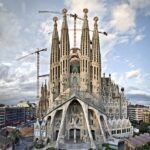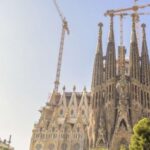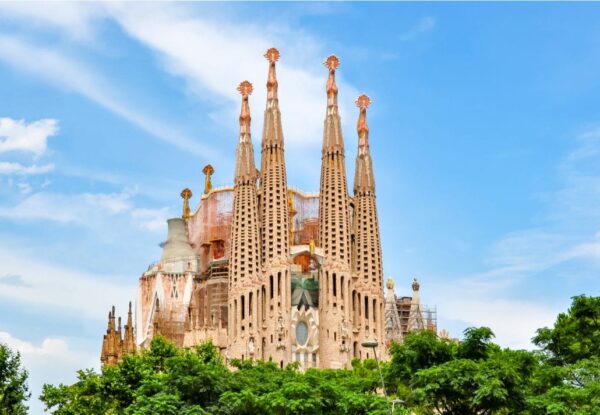
In the heart of Barcelona, the Sagrada Familia stands as a breathtaking testament to architectural brilliance and artistic vision. Designed by the renowned Antoni Gaudí, this basilica captures the imagination of millions, blending intricate details with soaring heights that speak to the divine.
The Magnificence of Sagrada Familia: Barcelona's Iconic Gem is not only a masterpiece of modernist architecture but also a symbol of the city's cultural identity. Its ongoing construction, which began in 1882, reflects a commitment to craftsmanship and innovation that continues to inspire awe in visitors from around the globe.
The Architectural Wonders of Sagrada Familia: A Deeper Look
The Sagrada Familia is not only an architectural wonder but also a profound exploration of nature and spirituality. Gaudí's vision integrates organic shapes and vibrant colors, inviting visitors to engage with the basilica on multiple levels. The play of light through its stained glass windows creates a dynamic atmosphere, altering the perception of space and height throughout the day.
One of the most striking features of the Sagrada Familia is its towers. Once completed, the basilica will boast 18 towers, each symbolizing different figures from Christianity. The tallest of these, dedicated to Jesus Christ, will soar to 172.5 meters, making it the highest church building in the world. The towers are designed to reflect a range of architectural styles, integrating both Gothic and Art Nouveau elements.
- Passion Facade: Represents the crucifixion of Jesus, with stark, angular designs that evoke emotion.
- Nativity Facade: Celebrates the birth of Christ with intricate, ornate carvings that showcase Gaudí's love for nature.
- Glory Facade: Symbolizes the resurrection and eternal life, still under construction, promising to be the most monumental of the three.
The interior of the Sagrada Familia is equally captivating, resembling a forest with its intricate columns that branch out like trees. This innovative design not only supports the structure but also creates a sense of tranquility and connection to the natural world. Gaudí’s use of hyperboloids and geometrical shapes allows for a harmonious balance between strength and beauty, embodying his philosophy that architecture should be an extension of nature.
Exploring the Symbolism Behind Sagrada Familia's Design Elements
The design elements of the Sagrada Familia are rich in symbolism, reflecting Gaudí’s deep understanding of spirituality and nature. Each façade, tower, and interior space carries a meaning that transcends mere aesthetics, inviting visitors to explore the intertwining of faith and art. For instance, the use of light plays a pivotal role, representing the divine presence that illuminates the spiritual journey.
One of the most profound aspects of Gaudí's design is the incorporation of natural forms. The columns in the nave mimic tree trunks, branching out to support the ceiling, which resembles a forest canopy. This connection to nature serves to remind visitors of their place within the universe, highlighting the sanctity of both the human experience and the natural world. Moreover, the dynamic shapes and colors of the stained glass windows evolve throughout the day, symbolizing the passage of time and the cycles of life.
- Trinity Towers: The towers dedicated to the Holy Trinity signify the importance of the Father, Son, and Holy Spirit within the Christian faith.
- Spiritual Journey: The progression from the Nativity Facade to the Passion Facade illustrates the life of Christ, guiding visitors through key moments of salvation history.
- Geometrical Harmony: Gaudí employed geometric forms to express the unity of nature and spirituality, reflecting his belief that all creation is interconnected.
Ultimately, the Sagrada Familia stands as a living testament to faith and creativity. Each design element is not merely for visual appeal; it serves to provoke thought and inspire reflection. As visitors explore this architectural marvel, they are invited to delve into a deeper understanding of the relationship between humanity and the divine, enriching their experience of this iconic gem in Barcelona.
The History of Sagrada Familia: From Vision to Reality
The Sagrada Familia's journey began in 1882, when architect Francisco de Paula del Villar initially proposed the project. However, it was the visionary Antoni Gaudí who took over the design in 1883, transforming it into a unique blend of Gothic and Art Nouveau styles. His deep religious convictions influenced every aspect of the basilica, which he envisioned as a place where architecture would tell the story of Christianity.
The construction of Sagrada Familia has progressed through various phases, reflecting the evolving techniques and materials available over the decades. Key milestones include:
- 1882: Groundbreaking ceremony marking the beginning of construction.
- 1914: Gaudí dedicates himself fully to the project, spending the last 15 years of his life on it.
- 1936: Civil War interrupts construction, leading to the loss of many original plans.
- 2026: The anticipated completion date, coinciding with the centenary of Gaudí's death.
Throughout its history, Sagrada Familia has faced numerous challenges, from financial constraints to political upheaval. Nonetheless, the dedication to Gaudí's vision has driven the project forward. Today, modern technology aids in the construction process, allowing artisans to replicate Gaudí's intricate designs more accurately than ever before.
The basilica not only serves as a magnificent work of architecture but also as a living symbol of perseverance and creativity. Each tower and façade encapsulates the dreams of countless architects and artisans, embodying the hope that one day, the vision of Gaudí will be fully realized. Visitors can witness this ongoing journey, as the Sagrada Familia remains a work in progress—a testament to faith and innovation.
Sagrada Familia: A Testament to Gaudí's Genius in Barcelona
The Sagrada Familia is a remarkable showcase of Antoni Gaudí's innovative genius, combining architectural audacity with deep spiritual symbolism. This basilica diverges from traditional church designs, reflecting Gaudí's belief that nature is the ultimate inspiration for architecture. As visitors approach, they are greeted by a structure that seems to grow organically from the ground, embodying a harmonious blend of form and function.
One of the most captivating aspects of the Sagrada Familia is its play of light, which transforms the interior into a celestial experience. Gaudí designed the stained glass windows to filter sunlight in a way that creates a vibrant tapestry of colors, evoking emotions and spiritual reflection. This dynamic interaction between light and space invites guests to contemplate their own faith journeys while marveling at the beauty around them.
- Symbolic Geometry: Gaudí employed complex geometric patterns to convey spiritual meanings, affirming his belief that mathematics and nature are intertwined.
- Organic Design: The use of natural motifs, such as tree-like columns, enhances the connection between the basilica and the environment, making the space feel alive.
- Continuity of Creation: Even as construction continues, the evolving design reflects a commitment to Gaudí's original vision, ensuring that each phase remains true to the overall aesthetic.
In essence, the Sagrada Familia is more than just a church; it is a living testament to the intersection of faith and artistry. As the basilica nears its completion, it stands as a reminder of the enduring power of human creativity and the spiritual aspirations that drive us to create and connect with the divine. Visitors leave not only in awe of its grandeur but also with a deeper appreciation for the intricate relationship between architecture and the sacred.
Visiting Sagrada Familia: Tips for an Unforgettable Experience
When visiting the Sagrada Familia, it’s essential to plan your trip in advance to maximize your experience. Consider purchasing tickets online to avoid long queues, especially during peak tourist seasons. Arriving early in the morning or later in the afternoon can also help you enjoy a quieter atmosphere, allowing you to appreciate the basilica's stunning details without the crowds.
To enhance your visit, consider booking a guided tour. A knowledgeable guide can provide invaluable insights into Gaudí's vision and the rich symbolism embedded in the architecture. Additionally, audio guides are available for those who prefer a self-paced exploration, offering detailed explanations about different aspects of the basilica, including its facades and interior design.
- Dress Code: Ensure you dress modestly, as the Sagrada Familia is a place of worship. Comfortable shoes are a must, as you will be walking and standing for extended periods.
- Photography: Capture the beauty of the basilica, but be respectful of other visitors and avoid using flash.
- Time Your Visit: Allocate at least a couple of hours to explore both the interior and exterior, including the museum dedicated to Gaudí's life and work.
Lastly, don’t miss the chance to explore the surrounding area. The Sagrada Familia is located near other famous landmarks, such as Park Güell and Casa Batlló, making it easy to immerse yourself in the architectural wonders of Barcelona. Each visit to this iconic gem promises to be an unforgettable journey into the heart of Gaudí's genius and the spiritual essence of the city.
The Ongoing Construction of Sagrada Familia: What to Expect in 2023
The ongoing construction of the Sagrada Familia continues to captivate visitors and locals alike, with significant progress anticipated in 2023. As the iconic basilica approaches its centenary of Gaudí's passing, the completion of various elements is on the horizon. Expect to see enhancements in both the exterior design and interior spaces that will further embody Gaudí's visionary ideals.
In 2023, the focus will be on completing the Glory Facade, the last of the three principal façades. This monumental façade will depict the glory of Jesus and is expected to feature intricate details that reflect Gaudí's deep spiritual insights. The construction process integrates modern technology to replicate Gaudí's original designs more accurately, ensuring that the beauty and intent of the basilica are preserved.
- Completion of the Glory Facade: Set to be the most grandiose of the façades, it will highlight the resurrection theme.
- Enhanced Visitor Experience: New pathways and viewing platforms will be developed, allowing better access and perspectives of the construction process.
- Technological Integration: Advancements in building techniques will ensure that the ongoing work closely aligns with Gaudí's vision.
Visitors in 2023 can look forward to interactive exhibits that educate about the construction phases and the architectural significance of the Sagrada Familia. Educational programs will engage guests in the history of this monumental undertaking, providing a deeper understanding of both the artistic craftsmanship and the spiritual journey that the basilica represents. As work progresses, the Sagrada Familia remains a living testament to Gaudí's genius and the unwavering dedication to completing this architectural masterpiece.
 The Intriguing History of Barcelona's Sagrada Familia
The Intriguing History of Barcelona's Sagrada Familia Exploring the Majestic Sagrada Familia in Barcelona: A Guide to Booking Tickets
Exploring the Majestic Sagrada Familia in Barcelona: A Guide to Booking Tickets Exploring the Majestic Interior of La Sagrada Familia in Barcelona
Exploring the Majestic Interior of La Sagrada Familia in BarcelonaIf you want to know other articles similar to The Magnificence of Sagrada Familia: Barcelona's Iconic Gem you can visit the category WHERE YOU CAN GO.
Leave a Reply










Read more!